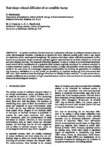Bed-slope-related diffusion of an erodible hump
| dc.contributor.author | Maldonado, S | |
| dc.contributor.author | Creed, MJ | |
| dc.contributor.author | Borthwick, Alistair | |
| dc.date.accessioned | 2021-08-22T18:12:29Z | |
| dc.date.available | 2021-08-22T18:12:29Z | |
| dc.date.issued | 2016-11-30 | |
| dc.identifier.isbn | 9781138029453 | |
| dc.identifier.uri | http://hdl.handle.net/10026.1/17725 | |
| dc.description.abstract |
In certain conditions, the bed slope has a substantial influence on sediment transport rates and hence morphological evolution. Approaches to account for such influence usually suffer from a high degree of empiricism and/or mathematical complexity. We propose a bed slope related diffusivity parameter, derived from a morphodynamic model previously validated against empirical data for bedload transport on horizontal and steep sloping channels. The proposed diffusivity parameter is easy to include in a conventional morphodynamic model via the modification of a typical bedload formula originally developed for sediment transport in a nearly horizontal channel. A conventional model modified through this parameter proves to yield enhanced results in the case study of a submerged migrating sandbar, by avoiding the generation of unrealistic high-frequency oscillations in the bed profile, yet permitting the expected steepening of its downstream face with time. Other models derived for sloping channels do not satisfy the latter condition. It is also shownthat unre-alistic oscillations can be avoided through numerical means; however, their use should be interpreted carefully from a hydrodynamic and sedimentological viewpoint. | |
| dc.format.extent | 690-695 | |
| dc.language.iso | en | |
| dc.publisher | CRC Press | |
| dc.title | Bed-slope-related diffusion of an erodible hump | |
| dc.type | conference | |
| dc.type | Conference Proceeding | |
| plymouth.publication-status | Published | |
| plymouth.journal | River Sedimentation - Proceedings of the 13th International Symposium on River Sedimentation, ISRS 2016 | |
| dc.identifier.doi | 10.1201/9781315623207-125 | |
| plymouth.organisational-group | /Plymouth | |
| plymouth.organisational-group | /Plymouth/Faculty of Science and Engineering | |
| plymouth.organisational-group | /Plymouth/Faculty of Science and Engineering/School of Engineering, Computing and Mathematics | |
| plymouth.organisational-group | /Plymouth/Users by role | |
| plymouth.organisational-group | /Plymouth/Users by role/Academics | |
| dc.rights.embargoperiod | Not known | |
| rioxxterms.versionofrecord | 10.1201/9781315623207-125 | |
| rioxxterms.licenseref.uri | http://www.rioxx.net/licenses/all-rights-reserved | |
| rioxxterms.type | Conference Paper/Proceeding/Abstract |


